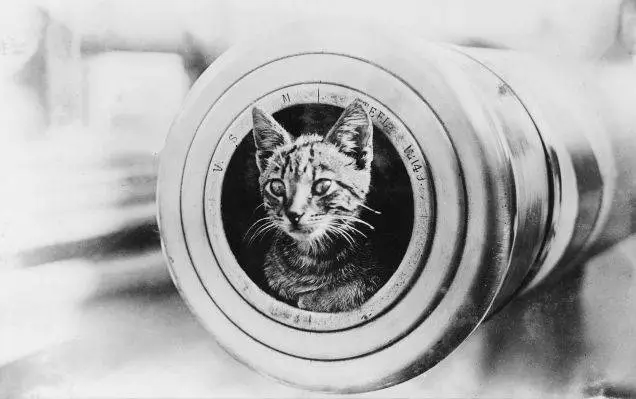Cats played a remarkable role during World War I amid the tumult of battles and the grim reality of life in the trenches. They were not just guardians against rats and mice on ships and in trenches but also offered solace and companionship to sailors and soldiers. Cats provided a sense of comfort and normalcy amidst the chaos of war, forming bonds that transcended the harsh circumstances.
During World War I, it’s estimated that half a million cats were deployed to the trenches, fulfilling crucial roles as mousers and ratters. Remarkably, some of these felines were even utilized for detecting poisonous gases, demonstrating their exceptional abilities. Furthermore, extending beyond their land-based contributions, cats were a common sight on ships, a tradition that has endured for thousands of years.
The History of Cats and Sailors
The ancient Egyptians were likely the first seafarers to realize the true value of having cats as shipmates. Sailors on long journeys benefited greatly from the company of cats, which not only provided much-needed companionship but also acted as crucial protectors against vermin infestations on ships. In the absence of cats, rats and mice could overrun a vessel, causing significant damage by consuming provisions, gnawing through ropes, and spreading diseases.

Additionally, many sailors held superstitious beliefs that cats brought good luck, further enhancing their value on seafaring voyages. It was common practice for crews to adopt cats from foreign lands they visited, serving not only as cherished souvenirs but also as constant reminders of their beloved pets back home.
Notably, some of these feline companions were even issued with cat passports, highlighting the significant role they played in the lives of sailors.
Cats on the Front Lines
One of the most famous cats of World War I was a tabby named Tom, a stray adopted by the British Army in 1914. He quickly became a beloved member of the regiment and was known for his bravery and resourcefulness. Tom was often seen running messages between the trenches, and he was even awarded the Blue Cross Medal for his service.

Another famous cat of World War I was a black cat named Smoky. Smoky was a rescue cat that was adopted by the American Red Cross in 1917. She quickly became a favourite of the soldiers and was known for her ability to sense danger. Smoky was often seen running ahead of the troops, warning them of enemy fire. She was also used to deliver messages and carry supplies.

Togo, Pincher, and Ching were also well-known feline ship mascots during WWI. Spark Plug was a feline mascot for an aviator squad. Pitouchi was probably the most famous feline of the ground troops. This cat was orphaned at a young age and was adopted by Lieutenant LeKeux of the Belgium military.
The Legacy of the Cats of World War I
Today, there are many memorials to the cats of World War I.

One of the most famous is the Animals in War Memorial in London, which features a statue of Simon the Cat, who was awarded a posthumous PDSA Dickin Medal for his devotion to duty despite suffering terrible injuries when the British warship was shelled by the Chinese Communist forces during the Yangtze Incident of 1949.

The cats of World War I are a reminder of the important role that animals can play in times of war. They are also a symbol of the resilience and courage of the human spirit. The cats of the World War I might be gone, but they will never be forgotten.



